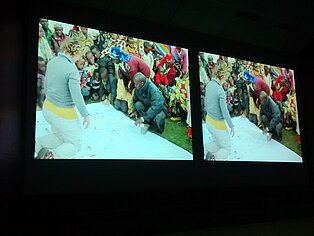Poorly constructed buildings kill more people than HIV, malaria, and Ebola put together
Stuttgart. The United Nations Universal Declaration of Human Rights was adopted in 1948 and since then, it has been regarded as the objective and guiding star of international development efforts. The 25th article of this declaration describes the right to housing and social security. Led by Robin Cross, who gave the last lecture at the Stuttgart 2014 November Talks, non-profit architecture organisation “Article 25” makes a clear reference to this right.
Living, infrastructure, and well-constructed buildings are not a luxury, but rather a fundamental basic right, emphasises Robin Cross, managing director of this special architecture office. The headquarters and the in-house think tank at Article 25 are based in London. Worldwide and working with local partners in what are known as “do tanks”, the organisation has already managed to bring projects for numerous schools and health centres to fruition.
“Poorly constructed buildings kill more people than HIV, malaria, and Ebola put together, and over 3,000 children die every day from the consequences of a lack of infrastructure such as safe water supply and disposal,” reports Cross. To clearly illustrate this precarious situation, he shows graphics detailing the number of victims of similarly powerful earthquakes in developed and developing countries. The shocking message of these figures? Good architecture and a solid construction type really do prevent the dreadful destruction and human tragedies that are virtually inevitable given the inadequate constructions found in earthquake zones. This is where the work starts for the architects at Article 25. This moving introduction is accompanied by informative images from Haiti of homes that fell down like houses of cards in a matter of seconds during the natural catastrophe that occurred there.
Robin Cross then draws on the typical architectural phases for the next part of his presentation and describes the design, planning, and construction process. First he put questions to the attentive listeners: How does planning and design work in crisis regions if the potential building owner no longer has an office, for example? What is to be done if an administrative body signs contracts but no one can read them on site? How can we visit the site if the substrate is a dangerous pile of ruins in the middle of a cut-off community? Instead of spending ages talking about it, you simply have to get stuck in: Robin Cross is convinced that after a catastrophe, the children affected need to get back to school as quickly as possible, as this is the only way that will allow them take their fate into their own hands one day.
Every stage of the work requires taking a close look at the local circumstances. Improvisation is what is needed on site and means a particular type of creativity when it comes to carrying out the work: What craftsmanship skills are available? What material is there and what can we make from it? Extreme functional and economical constraints result in unexpected, pragmatic solutions. For instance, if clay bricks can be produced on site, the school will be made out of clay bricks. If affordable roof battens can be acquired, the construction has to be adapted to the cross sections present. Long-term support to help people help themselves is offered by the collective construction workshops. As a result, the village community doesn't just benefit from the completed building, but also from the shared task that brings with it employment, social cohesion, and training in a skilled trade.
Article 25
About Us Presentation (Film | 3:21 Min.)
Robin Cross Die Menschenrechte als Arbeitsgrundlage (Film | 1:36 Min.)
Die Menschenrechte als Arbeitsgrundlage II (Film | 1:50 Min.)






